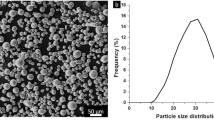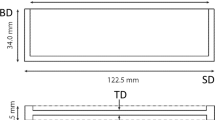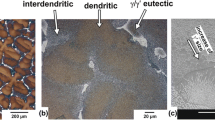Abstract
In this work, a commercial Co–Cr–Mo alloy fabricated by laser powder bed fusion (LBPF) was studied from the point of view of the microstructure of the as-built material, crack mechanism formation, mechanical properties, and residual stresses. Correlative characterization encompassing X-ray diffraction, optical and scanning electron microscopy supported by electron backscattered diffraction, nanoindentation, tensile testing, and residual stresses measurements were performed on the as-built and heat-treated samples. The anisotropic microstructure of the as-built Co–Cr–Mo samples is imposed by the heat flow condition along the building direction (BD), parallel to the z-axis. Cracks and pores were found at the cellular dendrite boundaries and grain boundaries. Only diffraction peaks corresponding to γ-Co (FCC) were observed through X-ray diffraction. The formation of M23C6 carbides was experimentally confirmed by electron backscatter diffraction analysis and predicted by the non-equilibrium solidification path simulation. After the Co–Cr–Mo alloy was heat-treated at 1050 °C for 2 h, the previous cellular structures were dissolved. The tensile properties of the heat-treated samples were reduced due to the microstructural heterogeneities such as voids together with coarsened secondary particles that existed at the grain boundaries.









Similar content being viewed by others
References
Jiang J, Xiong Y, Zhang Z, Rosen DW (2020) Machine learning integrated design for additive manufacturing. J Intell Manuf. https://doi.org/10.1007/s10845-020-01715-6
Jiang J, Newman ST, Zhong RY (2020) A review of multiple degrees of freedom for additive manufacturing machines. Int J Comput Integr Manuf 34:195–211. https://doi.org/10.1080/0951192X.2020.1858510
Kietzmann J, Pitt L, Berthon P (2015) Disruptions, decisions, and destinations: enter the age of 3-D printing and additive manufacturing. Bus Horiz 58:209–215. https://doi.org/10.1016/j.bushor.2014.11.005
Herzog D, Seyda V, Wycisk E, Emmelmann C (2016) Additive manufacturing of metals. Acta Mater 117:371–392. https://doi.org/10.1016/j.actamat.2016.07.019
Gu DD, Meiners W, Wissenbach K, Poprawe R (2012) Laser additive manufacturing of metallic components: materials, processes, and mechanisms. Int Mater Rev 57:133–164. https://doi.org/10.1179/1743280411Y.0000000014
Oliveira JP, LaLonde AD, Ma J (2020) Processing parameters in laser powder bed fusion metal additive manufacturing. Mater Des 193:1–12. https://doi.org/10.1016/j.matdes.2020.108762
Chimmat M, Srinivasan D (2019) Understanding the residual stress in DMLS CoCrMo and SS316L using X-ray diffraction. Procedia Struct Integr 14:746–757. https://doi.org/10.1016/j.prostr.2019.05.093
Patterson AE, Messimer SL, Farrington PA (2017) Overhanging features and the SLM/DMLS Residual stresses problem: review and future research need. Technologies 5:15. https://doi.org/10.3390/technologies5020015
Marchese G, Basile G, Bassini E et al (2018) Study of the microstructure and cracking mechanisms of hastelloy X produced by laser powder bed fusion. Materials (Basel):11. https://doi.org/10.3390/ma11010106
Engeli R, Etter T, Hövel S, Wegener K (2016) Processability of different IN738LC powder batches by selective laser melting. J Mater Process Technol 229:484–491. https://doi.org/10.1016/j.jmatprotec.2015.09.046
Tomus D, Rometsch PA, Heilmaier M, Wu X (2017) Effect of minor alloying elements on crack-formation characteristics of Hastelloy-X manufactured by selective laser melting. Addit Manuf 16:65–72. https://doi.org/10.1016/j.addma.2017.05.006
Qian B, Saeidi K, Kvetková L, Lofaj F, Xiao C, Shen Z (2015) Defects-tolerant Co-Cr-Mo dental alloys prepared by selective laser melting. Dent Mater 31:1435–1444. https://doi.org/10.1016/j.dental.2015.09.003
Yamanaka K, Mori M, Chiba A (2015) Assessment of precipitation behavior in dental castings of a Co-Cr-Mo alloy. J Mech Behav Biomed Mater 50:268–276. https://doi.org/10.1016/j.jmbbm.2015.06.020
Mineta S, Namba S, Yoneda T, Ueda K, Narushima T (2010) Carbide formation and dissolution in biomedical CO-CR-MO alloys with different carbon contents during solution treatment. Metall Mater Trans A Phys Metall Mater Sci 41:2129–2138. https://doi.org/10.1007/s11661-010-0227-1
Park JB, Jung KH, Kim KM, Son Y, Lee JI, Ryu JH (2018) Microstructure of As-cast Co-Cr-Mo alloy prepared by investment casting. J Korean Phys Soc 72:947–951. https://doi.org/10.3938/jkps.72.947
Guo F, Dong G, Dong L (2014) High temperature passive film on the surface of Co-Cr-Mo alloy and its tribological properties. Appl Surf Sci 314:777–785. https://doi.org/10.1016/j.apsusc.2014.07.086
Wang WJ, Yung KC, Choy HS, Xiao TY, Cai ZX (2018) Effects of laser polishing on surface microstructure and corrosion resistance of additive manufactured CoCr alloys. Appl Surf Sci 443:167–175. https://doi.org/10.1016/j.apsusc.2018.02.246
Erfanian-Nazif-Toosi HR, Rodriguez M, López HF (2020) Microstructural evolution and corrosion behavior of a laser surface modified cast Co–Cr–Mo–C alloy. J Biomed Mater Res - Part B Appl Biomater:1–10. https://doi.org/10.1002/jbm.b.34644
Zangeneh S, Lashgari HR, Lopez HF, Farahani HK (2017) Microstructural characterization of TIG surface treating in Co-Cr-Mo-C alloy. Mater Charact 132:223–229. https://doi.org/10.1016/j.matchar.2017.08.017
Sahami-Nejad M, Lashgari HR, Zangeneh S, Kong C (2019) Determination of residual stress on TIG-treated surface via nanoindentation technique in Co-Cr-Mo-C alloy. Surf Coat Technol 380:125020. https://doi.org/10.1016/j.surfcoat.2019.125020
Kim HR, Jang SH, Kim YK, Son J, Min B, Kim KH, Kwon TY (2016) Microstructures and mechanical properties of Co-Cr dental alloys fabricated by three CAD/CAM-based processing techniques. Materials (Basel):9. https://doi.org/10.3390/MA9070596
Barucca G, Santecchia E, Majni G, Girardin E, Bassoli E, Denti L, Gatto A, Iuliano L, Moskalewicz T, Mengucci P (2015) Structural characterization of biomedical Co-Cr-Mo components produced by direct metal laser sintering. Mater Sci Eng C 48:263–269. https://doi.org/10.1016/j.msec.2014.12.009
Darvish K, Chen ZW, Phan MAL, Pasang T (2018) Selective laser melting of Co-29Cr-6Mo alloy with laser power 180–360 W: cellular growth, intercellular spacing and the related thermal condition. Mater Charact 135:183–191. https://doi.org/10.1016/j.matchar.2017.11.042
Liu L, Ding Q, Zhong Y, Zou J, Wu J, Chiu YL, Li J, Zhang Z, Yu Q, Shen Z (2018) Dislocation network in additive manufactured steel breaks strength–ductility trade-off. Mater Today 21:354–361. https://doi.org/10.1016/j.mattod.2017.11.004
Zhou X, Li K, Zhang D, Liu X, Ma J, Liu W, Shen Z (2015) Textures formed in a CoCrMo alloy by selective laser melting. J Alloys Compd 631:153–164. https://doi.org/10.1016/j.jallcom.2015.01.096
Kajima Y, Takaichi A, Nakamoto T, Kimura T, Yogo Y, Ashida M, Doi H, Nomura N, Takahashi H, Hanawa T, Wakabayashi N (2016) Fatigue strength of Co-Cr-Mo alloy clasps prepared by selective laser melting. J Mech Behav Biomed Mater 59:446–458. https://doi.org/10.1016/j.jmbbm.2016.02.032
Kim KS, Hwang JW, Lee KA (2020) Effect of building direction on the mechanical anisotropy of biocompatible Co–Cr–Mo alloy manufactured by selective laser melting process. J Alloys Compd 834:155055. https://doi.org/10.1016/j.jallcom.2020.155055
Yamanaka K, Mori M, Sato S, Chiba A (2017) Stacking-fault strengthening of biomedical Co-Cr-Mo alloy via multipass thermomechanical processing. Sci Rep 7:1–13. https://doi.org/10.1038/s41598-017-10305-1
Mantrala KM, Das M, Balla VK, Rao CS, Kesava Rao VVS (2015) Additive manufacturing of Co-Cr-Mo alloy: influence of heat treatment on microstructure, tribological, and electrochemical properties. Front Mech Eng 1:1–7. https://doi.org/10.3389/fmech.2015.00002
AlMangour B, Luqman M, Grzesiak D, al-Harbi H, Ijaz F (2020) Effect of processing parameters on the microstructure and mechanical properties of Co–Cr–Mo alloy fabricated by selective laser melting. Mater Sci Eng A 792:139456. https://doi.org/10.1016/j.msea.2020.139456
Kajima Y, Takaichi A, Kittikundecha N, Nakamoto T, Kimura T, Nomura N, Kawasaki A, Hanawa T, Takahashi H, Wakabayashi N (2018) Effect of heat-treatment temperature on microstructures and mechanical properties of Co–Cr–Mo alloys fabricated by selective laser melting. Mater Sci Eng A 726:21–31. https://doi.org/10.1016/j.msea.2018.04.048
Razavi SMJ, Avanzini A, Cornacchia G, Giorleo L, Berto F (2021) Effect of heat treatment on fatigue behavior of as-built notched Co-Cr-Mo parts produced by Selective Laser Melting. Int J Fatigue 142:105926. https://doi.org/10.1016/j.ijfatigue.2020.105926
Takaichi A, Kajima Y, Kittikundecha N, Htat HL, Wai Cho HH, Hanawa T, Yoneyama T, Wakabayashi N (2020) Effect of heat treatment on the anisotropic microstructural and mechanical properties of Co–Cr–Mo alloys produced by selective laser melting. J Mech Behav Biomed Mater 102:103496. https://doi.org/10.1016/j.jmbbm.2019.103496
Wei W, Zhou Y, Sun Q, Li N, Yan J, Li H, Liu W, Huang C (2020) Microstructures and mechanical properties of dental Co-Cr-Mo-W alloys fabricated by selective laser melting at different subsequent heat treatment temperatures. Metall Mater Trans A Phys Metall Mater Sci 51:3205–3214. https://doi.org/10.1007/s11661-020-05719-y
Chlebus E, Gruber K, Kuźnicka B, Kurzac J, Kurzynowski T (2015) Effect of heat treatment on the microstructure and mechanical properties of Inconel 718 processed by selective laser melting. Mater Sci Eng A 639:647–655. https://doi.org/10.1016/j.msea.2015.05.035
Kajima Y, Takaichi A, Kittikundecha N, Htat HL, Cho HHW, Tsutsumi Y, Hanawa T, Wakabayashi N, Yoneyama T (2020) Reduction in anisotropic response of corrosion properties of selective laser melted Co–Cr–Mo alloys by post-heat treatment. Dent Mater 37:e98–e108. https://doi.org/10.1016/j.dental.2020.10.020
Sundman PSB (2008) TCFE6—TCS steels/Fe-alloys database, version 6.2.8
Karlsruhe F (2008) Inorganic Crystal Structure Database (ICSD). 1.1:1–14
Schneider CA, Rasband WS, Eliceiri KW (2012) NIH Image to ImageJ: 25 years of image analysis. Nat Methods 9:671–675. https://doi.org/10.1038/nmeth.2089
Sola A, Nouri A (2019) Microstructural porosity in additive manufacturing: the formation and detection of pores in metal parts fabricated by powder bed fusion. J Adv Manuf Process:1. https://doi.org/10.1002/amp2.10021
Antunes LHM, Hoyos JJ, Fonseca EB, Béreš M, da Silva Farina PF, Lopes ESN, Jardini AL, Filho RM (2019) Effect of phase transformation on ductility of additively manufactured Co–28Cr–6Mo alloy: an in situ synchrotron X-ray diffraction study during mechanical testing. Mater Sci Eng A 764:138262. https://doi.org/10.1016/j.msea.2019.138262
Yamanaka K, Mori M, Sato K, Chiba A (2016) Characterisation of nanoscale carbide precipitation in as-cast Co-Cr-W-based dental alloys. J Mater Chem B 4:1778–1786. https://doi.org/10.1039/c6tb00040a
Tonelli L, Fortunato A, Ceschini L (2020) CoCr alloy processed by Selective Laser Melting (SLM): effect of Laser Energy Density on microstructure, surface morphology, and hardness. J Manuf Process 52:106–119. https://doi.org/10.1016/j.jmapro.2020.01.052
Wang X, Read N, Carter LN et al (2016) Defect formation and its mitigation in selective laser melting of high γ′ Ni-base superalloys. Superalloys 2016:351–358
Yang J, Li F, Wang Z, Zeng X (2015) Cracking behavior and control of Rene 104 superalloy produced by direct laser fabrication. J Mater Process Technol 225:229–239. https://doi.org/10.1016/j.jmatprotec.2015.06.002
Lu Y, Wu S, Gan Y, Zhang S, Guo S, Lin J, Lin J (2016) Microstructure, mechanical property and metal release of As-SLM CoCrW alloy under different solution treatment conditions. J Mech Behav Biomed Mater 55:179–190. https://doi.org/10.1016/j.jmbbm.2015.10.019
Luo X, Li X (2014) Design and characterisation of a new duplex surface system based on S-phase hardening and carbon-based coating for ASTM F1537 Co-Cr-Mo alloy. Appl Surf Sci 292:336–344. https://doi.org/10.1016/j.apsusc.2013.11.141
Kazantseva NV, Ezhov IV, Davydov DI, Merkushev AG (2019) Analysis of structure and mechanical properties of Co–Cr–Mo alloy obtained by 3D printing. Phys Met Metallogr 120:1172–1179. https://doi.org/10.1134/S0031918X19120081
Prashanth KG, Scudino S, Klauss HJ, Surreddi KB, Löber L, Wang Z, Chaubey AK, Kühn U, Eckert J (2014) Microstructure and mechanical properties of Al-12Si produced by selective laser melting: effect of heat treatment. Mater Sci Eng A 590:153–160. https://doi.org/10.1016/j.msea.2013.10.023
Bawane KK, Srinivasan D, Banerjee D (2018) Microstructural evolution and mechanical properties of direct metal laser-sintered (DMLS) CoCrMo after heat treatment. Metall Mater Trans A Phys Metall Mater Sci 49:3793–3811. https://doi.org/10.1007/s11661-018-4771-4
Balbaa M, Mekhiel S, Elbestawi M, McIsaac J (2020) On selective laser melting of Inconel 718: densification, surface roughness, and residual stresses. Mater Des 193:108818. https://doi.org/10.1016/j.matdes.2020.108818
Ericsson T (1987) Residual stresses caused by thermal and thermochemical surface treatment. Adv Surf Treat IV:88–113. https://doi.org/10.1016/b978-0-08-034923-7.50012-7
Moazam MA, Honarpisheh M (2019) Residual stress formation and distribution due to precipitation hardening and stress relieving of AA707. Mater Res Express 6. https://doi.org/10.1088/2053-1591/ab59b6
Milagre MX, Franco M, Genezini F, Wimpory RC, Yokaichiya F, Costa I (2020) A correlation between microstructure and residual stress in the 6061 Al–Mg–Si alloy with different thermomechanical process. SN Appl Sci 2. https://doi.org/10.1007/s42452-020-03945-y
Acknowledgements
The authors want to thank the INCT-Biofabris for providing the Co–Cr–Mo samples. The LNNano/CNPEM is also acknowledged for the EBSD and XRD measurements (Project numbers SEM—23656; DRXP 21921).
Funding
This study was funded by the Conselho Nacional de Desenvolvimento Científico e Tecnológico (Project grant number PCI-DA 300148/2020-8). JPO acknowledges Fundação para a Ciência e a Tecnologia (FCT—MCTES) for its financial support via the project UIDB/00667/2020 (UNIDEMI).
Author information
Authors and Affiliations
Contributions
A.M.S.C.: conceptualization, investigation, methodology, writing—original draft; J.P.O.: conceptualization, investigation, methodology, writing—review & editing; A.L.J.: resources, writing—review & editing; E.G.B.L.: investigation, writing—review & editing; D.S.F.: investigation, writing—review & editing; M.J.M.: investigation, writing—review & editing; J.R.: conceptualization, investigation, methodology, writing—review & editing.
Corresponding author
Ethics declarations
Ethics approval
This research did not contain any studies with human participants or animals; thus, an ethics approval is not necessary.
Consent to participate
This research did not contain any studies with human participants; thus, a consent to participate is not necessary.
Consent for publication
This research did not contain any studies with human participants; thus, a consent to publication is not necessary. All authors have read and agreed to the published version of the manuscript.
Competing interests
The authors declare no competing interests.
Additional information
Publisher’s note
Springer Nature remains neutral with regard to jurisdictional claims in published maps and institutional affiliations.
Rights and permissions
About this article
Cite this article
da Silva Costa, A.M., Oliveira, J.P., Munhoz, A.L.J. et al. Co–Cr–Mo alloy fabricated by laser powder bed fusion process: grain structure, defect formation, and mechanical properties. Int J Adv Manuf Technol 116, 2387–2399 (2021). https://doi.org/10.1007/s00170-021-07570-w
Received:
Accepted:
Published:
Issue Date:
DOI: https://doi.org/10.1007/s00170-021-07570-w




